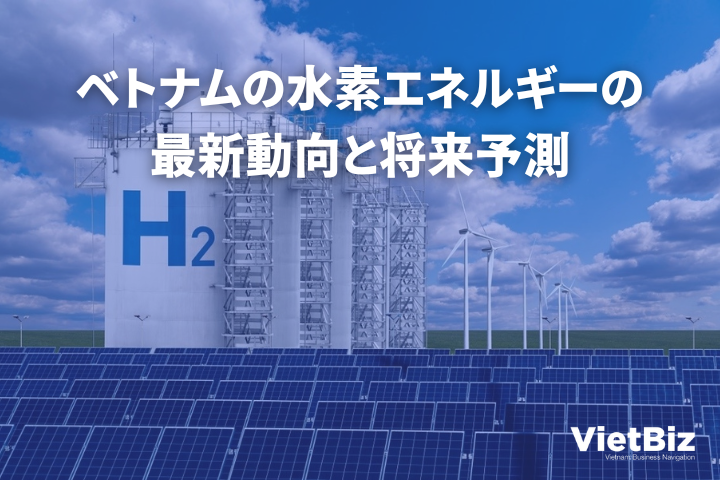Introduction
Vietnam is one of the countries that are focusing on the development of renewable energies with the aim of achieving zero carbon (real zero greenhouse gas emissions) by 2050. 2020, coal-fired power will still be the most dominant method of power generation, but the share of renewable energies is growing every year.
Vietnam has one of the highest levels of solar radiation and wind conditions in Asia, and has ample potential for further development of renewable energy in the future. One renewable energy source that is showing new promise in Vietnam is hydrogen.
This report examines the promise of hydrogen energy in Vietnam and its future prospects. It contains information that is particularly useful for Japanese energy companies and businesspeople in related industries who are considering expanding overseas.
Why Hydrogen Energy (renewable energy) Is Promising in Vietnam
This chapter will explain three main reasons why renewable energy, including hydrogen energy, is promising in Vietnam.
Electricity Shortage
According to the results of an estimate of electricity supply and demand from 2022 to 2025 conducted by the Electricity Generating Company of Vietnam (EVN), securing electricity supply during this period will face a number of difficulties, including the fact that procurement for coal-fired power generation, which accounts for about half of the total electricity generated in the country, will not progress due to soaring coal prices, and that the power supply to the north is limited due to transmission capacity limitations of newly started power sources, mainly in the central and southern regions, which could cause electricity shortages in the northern regions.
Currently, the northern part of the country accounts for nearly 50% of the nation’s electricity consumption demand, and is expected to continue to show higher growth than the national average. Electricity consumption in the region often surges, especially during the peak heat period from May to July.
Faced with this difficult situation, EVN proposes the immediate creation of a mechanism to develop renewable energy in the North.
decarbonation
In recent years, Vietnam’s rapid economic growth has been accompanied by an ever-increasing amount of greenhouse gas emissions, which has had many negative effects on the environment.
The industrial sector that emits the most greenhouse gases in Vietnam is power generation, followed by manufacturing, construction, and transportation. In order to reduce greenhouse gas emissions and achieve zero emissions by 2050, Vietnam is encouraging the development of clean energy sources in the coming years.
Government Encouragement
In recent years, the Vietnamese government had launched a number of policies and plans to develop sustainable and environmentally friendly energy sources. Hydrogen energy, with its many advantages, is one of the priority energy sources in R&D investments. According to Prime Minister’s Decision 38/2020/QD-TTg, projects applying hydrogen energy technology are eligible for investment incentives under the Law on Investment in High-Tech Sectors.
What Is Hydrogen Energy?
Hydrogen energy is energy produced from hydrogen (H2).
Hydrogen is present in small amounts in the atmosphere, but in nature it often exists as a compound combined with other elements, etc., and is therefore created from water and hydrocarbon compounds, including methane (CH4). Therefore, to produce hydrogen energy, hydrogen must first be created from naturally occurring hydrogen compounds. Then, the hydrogen is burned, and that combustion is utilized as heat energy, and the only byproduct is water.
In other words, hydrogen energy has only water as a byproduct and does not produce carbon dioxide, the main cause of the greenhouse effect.
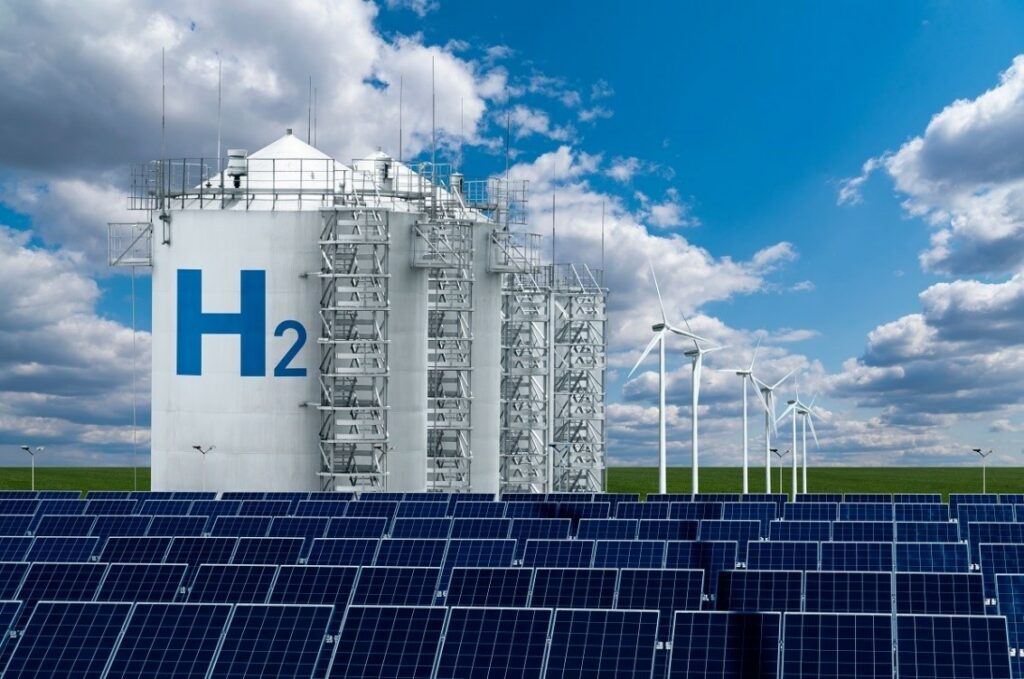
出所:Vietnam Clean Energy Association
Advantages of Hydrogen Energy
This section will list and explain the benefits of hydrogen energy.
Clean energy without CO2 emissions
If hydrogen is produced solely from renewable energy sources, such as wind, hydro, and solar power, the entire process of hydrogen energy production would emit essentially no CO2 or hazardous waste. This will contribute to the realization of the world’s 2050 carbon neutrality plan.
Renewable Energy
Hydrogen is considered a renewable energy source that can effectively replace increasingly depleting fossil fuels. Hydrogen can be procured from naturally occurring hydrogen compounds like water, and renewable energy can be used for combustion to generate heat energy.
High Efficiency
There are two ways to use hydrogen as a power source to drive a vehicle: combustion of hydrogen in an internal combustion engine, or generation of electricity by a fuel cell that uses hydrogen to drive an electric motor.
The fuel cell system is safer than the internal combustion engine system, which requires combustion, because the fuel cell system electrically reacts oxygen and hydrogen in the fuel cell to generate electricity to drive an electric motor and water as an emission. In addition, the energy efficiency of fuel cell vehicles is thought to be about twice that of gasoline internal combustion engine vehicles, and many economic benefits are expected.
Storable
Hydrogen energy can be stored and transported in natural gas (LNG) transportation infrastructure, making its use more convenient and allowing for long-term storage.
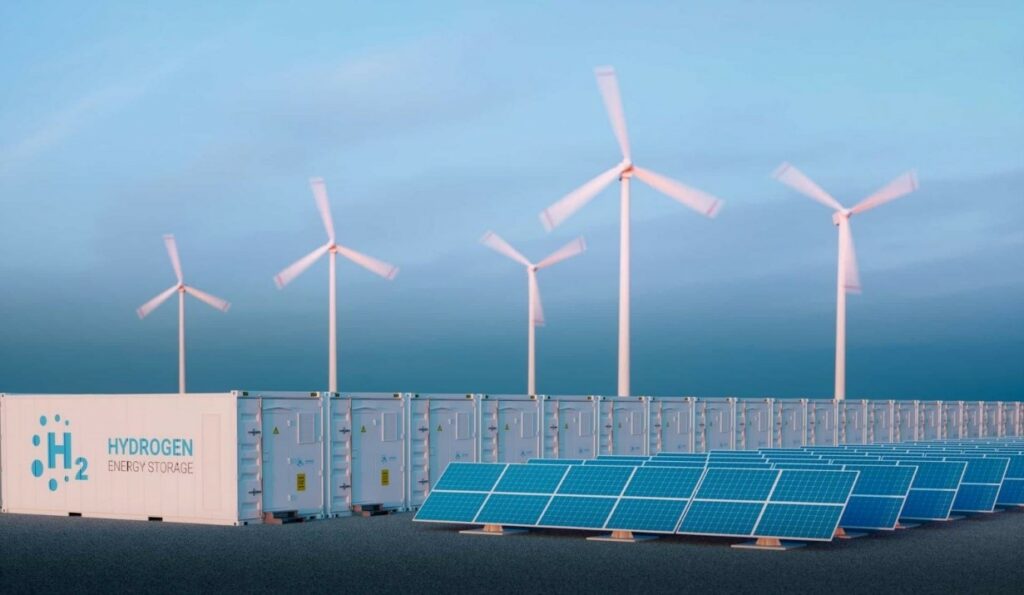
Hydrogen Production Method
Here we will show you how hydrogen is produced.
- Thermochemical methods for hydrocarbon fuels
This method utilizes thermochemical fuels such as natural gas, oil, coal, and biomass. Currently, about 90% of the world’s hydrogen is produced by this method. This method can be subdivided into the following three categories
- Natural gas steam reforming
This is now a common and economical industrial production method for hydrogen, which can separate hydrogen from natural gas, mainly methane (CH4) (CH4 + 2H2O → CO2 + 4H2). However, since this method still produces CO2, it is not applied to power generation and is mainly used in the fields of chemistry, fertilizer, and petrochemistry.
- Gasification heavy hydrocarbon
Heavy hydrocarbons such as petroleum and coal are gasified in the absence of oxygen at a temperature of about 1,400°C to produce H2 and CO. The CO gas continues to react with steam and catalysts and is converted to CO2 and H2. This method is quite popular because it can utilize existing infrastructure and equipment in the petrochemical industry. However, this method also produces CO2, which is harmful to the environment. It is also not a sustainable method because the fuel is gradually depleted.
- Biomass gasification and pyrolysis
In this method, biomass is turned into a gaseous state in a high-temperature gasification process to generate steam, which is condensed to produce hydrogen thermochemically.
The feedstock for this method is a very wide variety of biomass resources, including agricultural and forestry residues (straw, corn cobs, dried leaves, wood chips, etc.), waste, and methane from landfills and wastewater treatment plants. This hydrogen production method is considered a renewable, sustainable, and environmentally friendly energy production method.
- Methods of electrolysis of water
The use of electric current to break down water into hydrogen and oxygen is considered an “environmentally friendly” method because it does not emit any CO2, but it is quite costly. Currently, the following three electrolysis technologies are commonly used:
- Conventional electrolysis: Water or alkaline solution as electrolyte
- High temperature steam electrolysis (800-1000°C): Reduces electricity consumption by supplying part of the heat needed for the electrolysis process. The heat supplied is mainly from solar energy and surplus heat from other industrial energy processes.
- Water electrolysis with renewable energy power: incorporate renewable energy sources such as solar, wind, and hydroelectric power into the electrolysis process. Although this technology requires very high costs, it is environmentally friendly, sustainable, and is considered a future trend in hydrogen energy development. Hydrogen produced from renewable energy sources is also referred to as “green hydrogen.
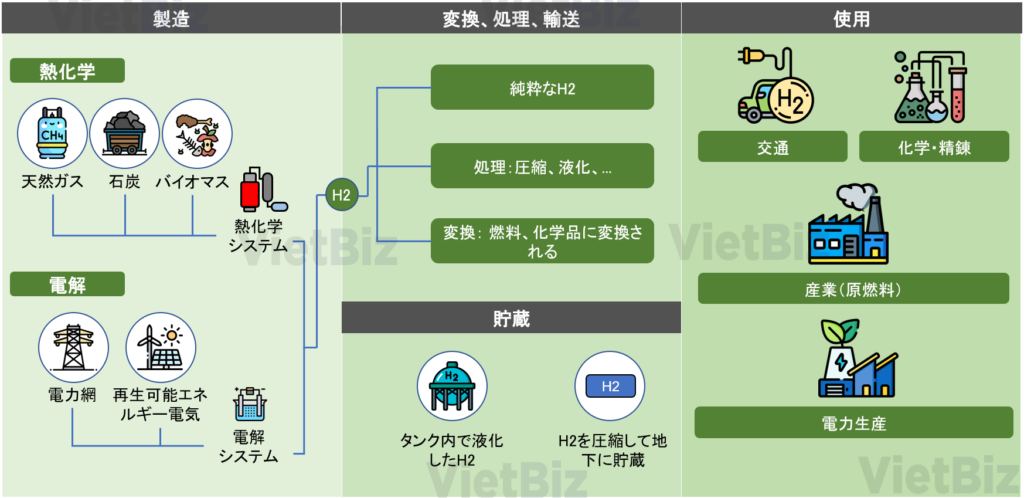
Vietnam Government Policy
The Vietnamese government has long recognized the benefits and role of hydrogen energy in particular and renewable energy in general in the development of a sustainable and environmentally friendly economy. This is reflected in the following directions and commitments
- In 2020, the government, through Resolution No. 55-NQ/TW and Resolution No. 140/NQ-CP, set the development of renewable energy and environmental protection as long-term goals:
(i) The share of renewable energy in total primary energy supply will reach about 15-20% in 2030 and 25-30% in 2045.
(ii) Reduce greenhouse gas emissions from energy activities to 15% by 2030 and 20% by 2045.
The two resolutions also state that hydrogen is an energy source that Vietnam should focus on because it is a clean and renewable source of energy and is expected to develop over the long term.
Specifically, the strategy for developing this energy source is to “promote technological research, development of pilot projects, and use of hydrogen energy for hydrogen energy production.
- On July 24, 2020, the Prime Minister reviewed Vietnam’s Nationally Determined Contribution (NDC) under COP21, with the goal of reducing greenhouse gas (GHG) emissions by 9% with domestic resources and 27% with international assistance by 2030.
- In Decision No. 38/2020/QD-TTg of December 30, 2020, the PM stipulated “hydrogen energy technology” on the list of advanced technologies with high priority for development and investment.
Hydrogen energy technology includes green hydrogen production technology, hydrogen transportation and storage technology, and hydrogen utilization technology, etc. Projects applying hydrogen energy technology are eligible for investment incentives under the Law on Investment in High-Tech Sectors.
It is clear that the Vietnamese government has taken early action to demonstrate its interest in hydrogen energy development. However, in order to realize hydrogen energy development in Vietnam as soon as possible, the following drastic and concrete actions need to be taken by the government and ministries:
- Develop specific development roadmaps, strategies, and directions.
- Implement a research program on hydrogen.
- Create a legal framework to govern hydrogen development activities in the energy sector.
- Develop LNG storage and transportation infrastructure and transmission networks for common use of hydrogen.
- Further increase public awareness of green hydrogen.
- Train and develop human resources in the renewable energy sector.
CO2 Emissions in Vietnam
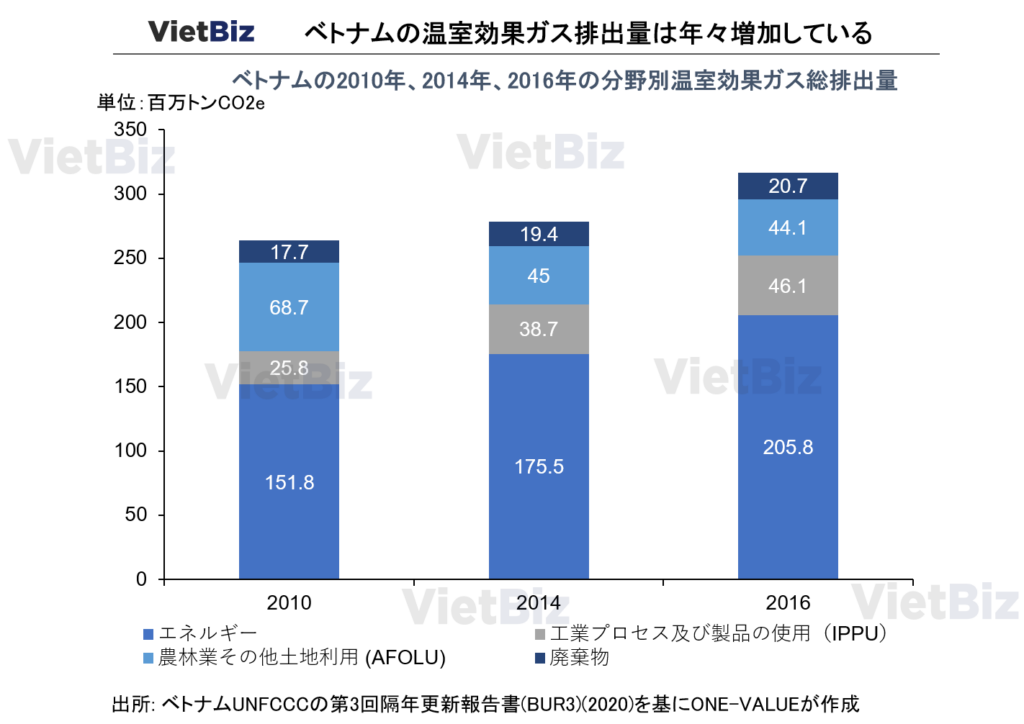
*CO2e (Carbon dioxide equivalent):carbon dioxide equivalent figure
*The timelines for 2010, 2014, and 2016 were selected because they are the most recent years in which Vietnam conducted a national greenhouse gas inventory; the figures for 2010 and 2014 are the result of recalculations.
Between 2010 and 2016, Vietnam’s GHG emissions increased 1.2-fold from 264.2 million tons CO2e to 316.7 million tons CO2e.
Vietnam’s total greenhouse gas emissions are projected to increase to 466 million tons CO2e in 2020 and 760.5 million tons CO2e in 2030.

Major emission sources
For emission sources, Vietnam conducted GHG inventories in four sectors: power generation industrial processes and product use (IPPU), agroforestry and other land uses (AFOLU), and waste.
In 2016, the energy sector accounted for the largest share of GHG emissions at 65%, followed by the IPPU sector at 14.6%; the AFOLU sector accounted for the third largest share at 13.9%, and the smallest share was in the waste sector at 6.5%.
Energy
In 2016, the energy sector emitted 205.8 million tons CO2e of greenhouse gases, accounting for 65% of total emissions and 35.5% more than in 2010.
Greenhouse gas emissions from this sector come mainly from the combustion of fuels (accounting for about 90%). Of these, the energy industry is the largest emitter, emitting 91 million tons of CO2e, or 44.2% of the energy sector’s total emissions.
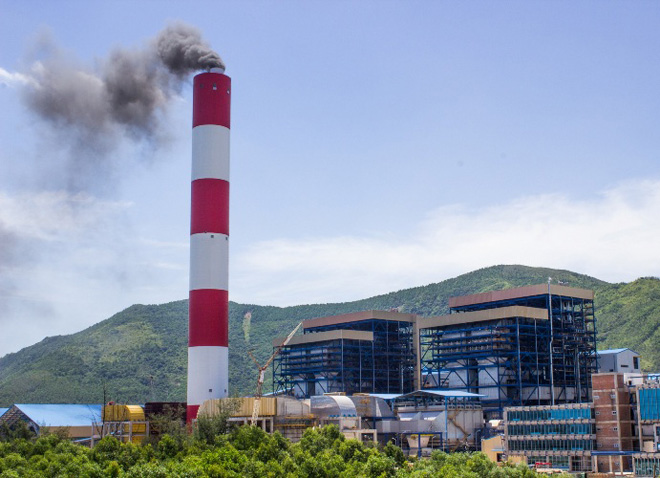
Industrial Process and Product Use (IPPU)
The total GHG emissions of the IPPU sector in 2016 were 46.1 million tons CO2e, nearly doubled compared to 2010.The main industrial production subsectors in the IPPU sector are (1) mining, (2) chemical industry, (3) metallurgy, and (4) use of substitutes for ozone-depleting substances. The mining industry is the largest emitter of greenhouse gases, reaching 40.9 million tons of CO2e and accounting for about 90% of the total emissions of the IPPU sector. Among the mining industries, cement production is the industry with the highest GHG emissions (36.8 million tons CO2e) due to its high energy and heat source consumption.
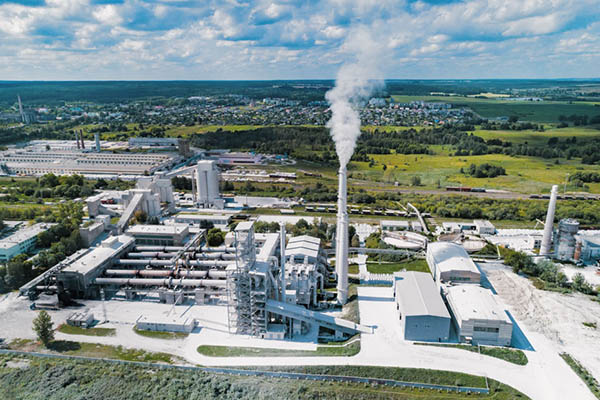
Agriculture, Forestry and Other Land Use
Total greenhouse gas emissions in the AFOLU sector in 2016 were 44.1 million tCO2e, a 35.9% decrease compared to 2010. Of this total, forest lands absorbed the most at -54.6 million tCO2e, while rice cultivation emitted the most at 49.7 million tCO2e. The three main sources of emissions in rice production are:
- Causes N2O emissions.
- Causes CH4 emissions.
- Causes CO2 emissions.

Waste
The total greenhouse gas emissions of the waste sector in 2016 were 20.7 million tons CO2e. GHG emissions from this sector were mainly: (1) emissions from solid waste landfills, (2) emissions from biological methods of solid waste treatment, (3) emissions from waste incineration, and (4) emissions from wastewater treatment and discharge. Of these, emissions from solid waste landfills were the largest, accounting for 50.3% of the total, or 10.4 million tons CO2e, followed by emissions from wastewater treatment and discharge, which accounted for 43%, or 8.9 million tons CO2e.
In general, Vietnam’s greenhouse gas emissions are only about 0.5% of global emissions, but they are increasing rapidly. Activities with high emissions and that have continued to increase in recent years include energy production, manufacturing, construction, transportation, cement production, and solid waste landfills. If energy production, IPPUs, and waste are the sectors that have sustained increases in GHG emissions, ALOFU is the only sector that has seen a decrease. This is the result of effective forest protection and reforestation programs implemented in previous years.
Government Policy for Resolution
Faced with an ever-increasing greenhouse gas situation, governments and other agencies had issued a number of policies and guidelines to reduce greenhouse gas emissions, including
- The “Renewable Energy Development Strategy to 2030 and Vision to 2050” was promulgated. It emphasized the promotion of the development of clean and renewable energy sources such as solar, wind, biomass, and solid waste power.
- The Climate Change Action Plan for 2016-2020 was published.
- Approved the “National Integrated Solid Waste Management Strategy to 2025 and Vision for 2050”.
A Case Study of Hydrogen Energy Development in Vietnam
This chapter will present a case study of hydrogen energy development in Vietnam.
Examples of Hydrogen Production
Green Hydrogen Production Plant Project in Chabin Province (under construction)
Construction of this project, in which The Green Solutions is investing, began in mid-January 2022 in Chavin Province. The plant will have an annual production capacity of 24,000 tons of hydrogen. By-products will include ammonia, which will be fed into the production of nitrogen fertilizer, and oxygen for medical use. The total investment for the project is approximately VND8 trillion (equivalent to US$300 million).
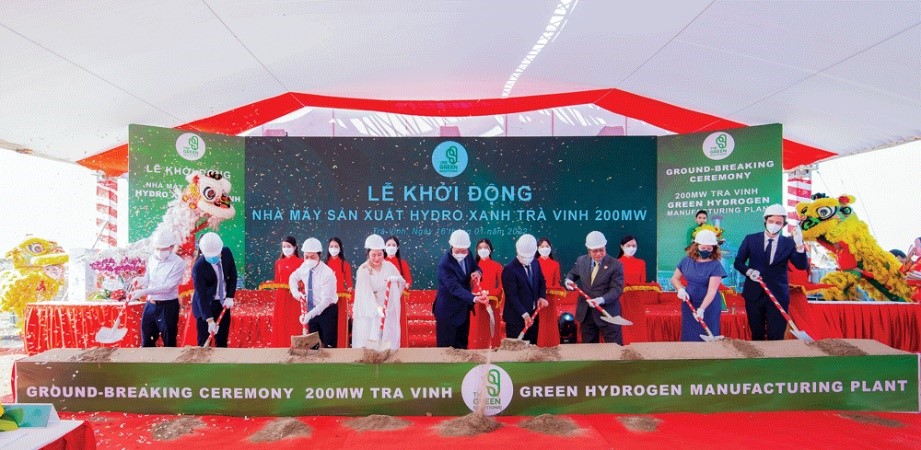
Examples of Hydrogen Energy Utilization
Research activities for a combined model of offshore wind power and hydrogen production
Located in a tropical monsoon climate and with more than 3,000 km of coastline, Vietnam has favorable conditions for the development of offshore wind power. According to a report by the Electricity Generating Company of Vietnam (EVN), as of the end of October 2021, there are currently 35 offshore wind power projects being studied and deployed in Vietnam, with total capacity expected to reach up to 60 GW.
However, the large amount of money and complex technology required to build a power transmission system from the sea to the land is a major obstacle to the development of offshore wind power in Vietnam. Without a power transmission system, the electricity generated cannot be fed into the national grid, resulting in wasted electricity.
Therefore, a model combining offshore wind power generation and hydrogen production has been proposed. Specifically, a portion of the electricity generated by the wind turbine is supplied to a hydrogen electrolysis plant at sea, where hydrogen gas is stored in gas or liquefied containers and transported to land by air or sea. After production, the hydrogen gas is used for power generation, industry, transportation, fertilizer production, and chemicals. Thus, the combination of offshore wind power projects and green hydrogen production will not only reduce the investment burden on the domestic power grid system, but also solve the problem of excess electricity and create a renewable and environmentally friendly fuel source.
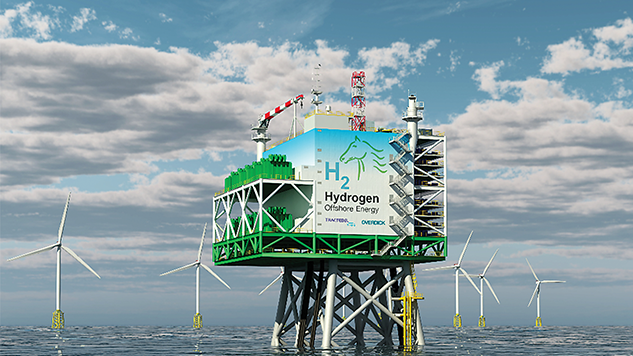
出所:Vietnam Economic Science Association
Several research and development cooperation activities were conducted to draw attention to the potential of this model:
- PECC2’s Study on a Model for Combining Offshore Wind Power and Hydrogen Production
In mid-2021, Power Construction Consulting Joint Stock Company 2 (PECC2) will conduct a study on the topic “Study on a model for offshore wind power generation producing hydrogen by electrolysis under Vietnamese conditions – calculations for a typical project with 150 MW capacity”, to be completed in early 2022.
- Research cooperation on hydrogen production from offshore wind power in Vietnam
At the end of March 2021, GIGON Consulting and Technology Solutions Group (Germany) and Vietnam Petroleum Institute (VPI) signed a memorandum of understanding on research cooperation for a pilot project using new technology to produce hydrogen from offshore wind power in Vietnam.
- Hydrogen production project by seawater electrolysis using offshore wind power generation (proposed)
At the end of 2021, Enterprize Energy Group (UK-Singapore) and European investors proposed to the government to implement the Thang Long Wind Power 2 Investment Project (TLW2). This project will use offshore wind power from the Thang Long Offshore Wind Power Project (Binh Thuan Province) to produce hydrogen through electrolysis of seawater. The project size is 2,000 MW with a total investment of approximately US$5 billion. The project is scheduled to be implemented from 2022 to 2030.
Summary and Future Outlook
The above information shows that hydrogen is a renewable energy source that can replace depleting fossil fuels and contribute to solving the problem of greenhouse gas emissions, which is a global concern.
In Vietnam, besides maintaining existing renewable energy sources such as solar energy, wind energy, and biomass energy, the development of hydrogen energy is also considered a potential solution. However, access to this energy still faces many challenges due to limited capital and scientific and technological capabilities. The government has also provided some direction for the sector, but it is still general and not yet embodied in a detailed roadmap or strategy. In the past two years, several research activities and projects have been proposed and implemented on hydrogen production, especially on models that combine hydrogen production and offshore wind power. Although these activities and projects are few in number, they are an important prerequisite for hydrogen energy development in Vietnam and an important first step to quickly catch up with global clean energy development.
【関連記事】ベトナムの再生可能エネルギーと関連分野については、こちらの記事も合わせてご覧ください。
ベトナム市場調査レポート一覧はこちらからもご覧頂けます。

ベトナム市場の情報収集を支援します
ベトナム市場での情報収集にお困りの方は多くいらっしゃるのではないでしょうか。
VietBizは日本企業の海外事業・ベトナム事業担当者向けに市場調査、現地パートナー探索、ビジネスマッチング、販路開拓、M&A・合弁支援サービスを提供しています。
ベトナム特化の経営コンサルティング会社、ONE-VALUE株式会社はベトナム事業に関するご相談を随時無料でこちらから受け付けております。
